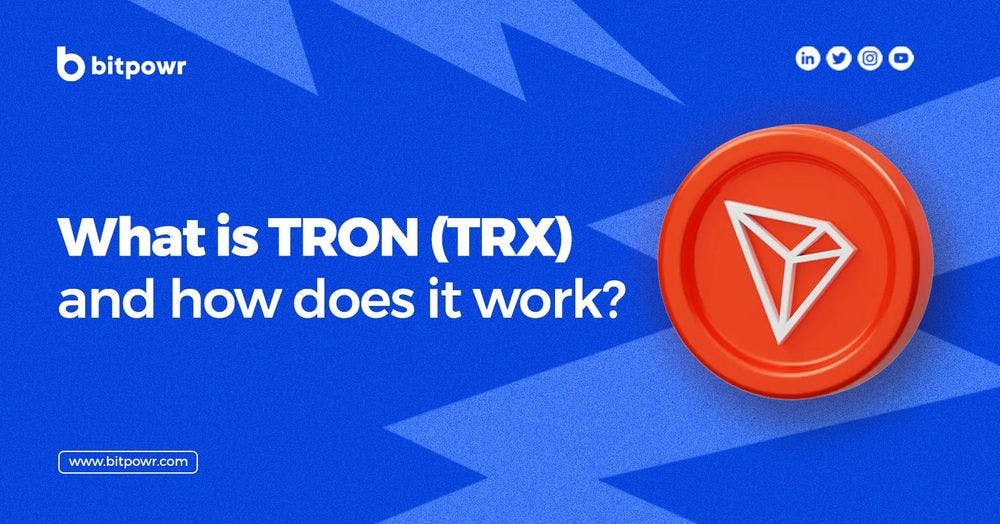Tron (TRX) is a blockchain-based digital platform that primarily hosts entertainment applications, with its in-house cryptocurrency, called Tronix or TRX.
Founded in 2017 by the Singapore non-profit organization, the Tron Foundation. Tron aims to create a global entertainment system for the cost-effective sharing of digital content. The platform has its roots in Asia but has now expanded globally, with over 180 million accounts as of August 2023.
Tron operates as a decentralized platform that uses blockchain and peer-to-peer (P2P) network technology to eliminate middlemen, allowing content creators to sell their work directly to consumers.
Developers use the Solidity programming language to create apps that are hosted on the Tron platform.
Users of the network pay content creators using TRX, which is the currency used on the network.
How does TRON work?
TRON operates on a three-layer protocol that includes a storage layer, core layer, and application layer, each optimized for specific functionalities.
The core layer performs tasks such as driving the innovative consensus procedure for adding new blocks to the chain, managing accounts, and overseeing smart contracts. The storage layer is optimized for complex data storage needs within the evolving blockchain, providing a high level of stability and security.
The application layer is designed to support the development of decentralized applications (DApps) and other functionalities. TRON also uses a delegated proof-of-stake consensus mechanism, which allows for high transaction throughput and lower fees compared to other blockchains. The platform processes up to 2,000 transactions per second, making it one of the fastest blockchain platforms. TRON has been compared to Ethereum in terms of its blockchain structure and features, such as decentralized applications (DApps), smart contracts, and tokens. However, TRON has been criticized for borrowing rather than building the basics of its platform, but it has also been praised for focusing on good user experience and design.
Use Cases and Applications of TRON
Tron (TRX) has several use cases that make it stand out in the cryptocurrency market. Here are some of the key use cases for Tron:
1. Low Transaction Fees
Tron has a transaction fee of about 0.82% TRX, which is significantly lower than Ethereum’s gas prices.
Additionally, content creators on the platform do not have transaction fees, making it more cost-effective for users. Tron’s proof-of-stake consensus mechanism also makes it more environmentally friendly compared to Bitcoin’s proof-of-work consensus mechanism.
2. TRC-20 Token Standard
Since Tron uses a three-layer protocol that includes storage, core, and application layers, similar to Ethereum’s ERC-20 protocol, This allows developers to create and issue tokens on the Tron network, which can be used for various purposes, such as fundraising, loyalty programs, and more.
3. Smart Contract-Based Financial Projects
Tron is used in smart contract-based financial projects, including decentralized exchanges (DEXs), lending platforms, and yield farming opportunities.
Many projects are powered by TRX and TRC-20 tokens, providing users with opportunities to earn rewards and interest within the Tron ecosystem.
4. Decentralized Applications (DApps)
Developers can build and deploy DApps on the TRON network, covering a wide range of use cases, including gaming, social media, DeFi, and more.
TRX is used as a means of exchange and to interact with these DApps, making it a versatile cryptocurrency within the ecosystem.
5. Cross-Chain Activities
Tron’s interoperability with other blockchains allows it to be used for cross-chain activities, asset transfers, and engaging with DApps on different blockchain networks. This means Tron can be deployed on popular blockchains to be received as a valid token on such chain. For Instance, Tron can be deployed on USDC so that USDC_Tron can be received.
This makes TRX a valuable asset for users looking to explore various blockchain ecosystems. These use cases have contributed to Tron’s growth and potential as a competitive cryptocurrency, particularly in the Custody and decentralized finance (DeFi) sector.
6. Global Entertainment System
Tron aims to create a global entertainment system that allows content creators to sell and fully control their content, challenging large media platforms like Netflix, Instagram, and Google.
By using peer-to-peer communication, Tron eliminates the need for third parties, providing content creators with more control and lower fees.
As TRON’s ecosystem continues to grow and evolve, it remains an intriguing option for those seeking to explore the potential of decentralized technologies.




